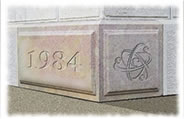Corporate Cornerstones
A reader once asked…”Why is this blog called Cornerstones?”
“In 1905 construction began on the new Northern Trust Bank building built of granite, marble and other materials that would last. Strong concrete pillars reached down to bedrock — 105 feet below street level to carry the heavy structure above. Years later, City Engineers, saying they considered the building “sag proof” cut into Northern’s Cornerstone, a “Bench Mark” known as the “Number One City Datum.” From this mark, the heights of all future structures in Chicago would be measured.”
– Excerpted from A History of The Northern Trust Bank
Everything starts somewhere.
Children draw lines in the dirt and create sides, teams, forts and castles.
Adults survey and plat, lay granite cornerstones; and erect buildings, and cities.
Cornerstones are important. They define and separate what’s “out there” from what’s “in here.” They “mark a moment” in history and provide a sharp edge to measure against. Sometimes, as with Northern Trust, they provide a solid standard against which other structures are gauged. We can “return to source” and touch their cool crystalline surfaces when we need a reminder of who we are, where we began; how far we’ve come.
Corporations don’t have cornerstones; they have Founders, who characterize “the soul of the company.” Lofty Vision. Sharp Edges. Distinctive Styles. Uncompromising standards; against which you often fall short. Their “lines in the dirt” tell you which side you’re on, whether you’re winning or losing and how well you’re playing. Taking your cues from them, you know you’re doing something worthwhile. Who needs a “stone” when you have “Steve Jobs?” (Apple’s unique products emerge from a unique corporate culture…and earn a consistent premium. Causal Link?)
Unfortunately, the “Soul” of the company often dies with the founder – unless the successor managers can keep it hot and alive by reminding people of the standards, the style, the spoken history and the practical distinctions that make “the way we do it here” special, unique and meaningful. They succeed because they keep the culture alive. We call this “Cultural Cornerstones.”
Of course, the myths and lore of company history are unique, but the practical foundation standards usually equate to Communication, Sales, Management and Strategy. In this core group of skills and practices, a “Corporate Anthropologist” can find the styles, standards, practices and unique features that define this “culture” as one of a kind. Management can keep that distinction – or not.
In the absence of a sharp management team that builds, maintains and evolves culture by design, firms tend to de-volve down into the generic and futile exercise of managing profit-yield by quarter…(the default worldwide standard of late)…the classic signature of dinosaurs approaching extinction.
Maybe you’re not a “Founder.” But as a successor, you too can draw a line in the dirt, lay a stone, raise a standard to evolve and protect your firm’s most valuable asset – its culture! This is your most important work.
Look around! You’re living and working among the “cultural icons” put in place by previous generations. If the founder is still around, speak with her – touch the stone! If not, find the relic and polish it. And put the others in touch with what it represents – who you are – and what you stand for.
We’ll be here to remind you – week by week.
That’s why we call it “Cornerstones.”
Subscribe to our Newsletter



